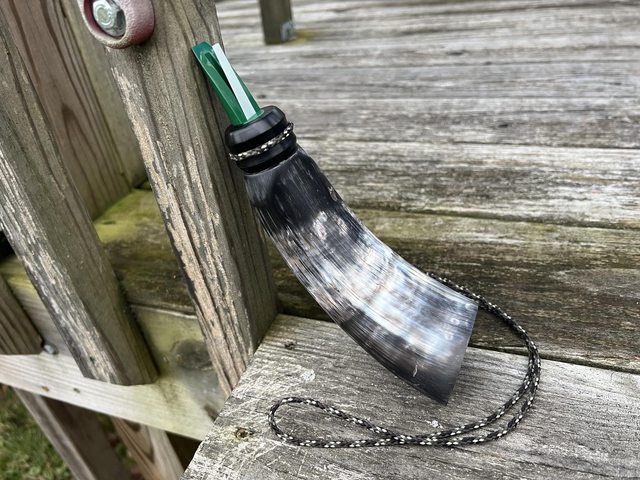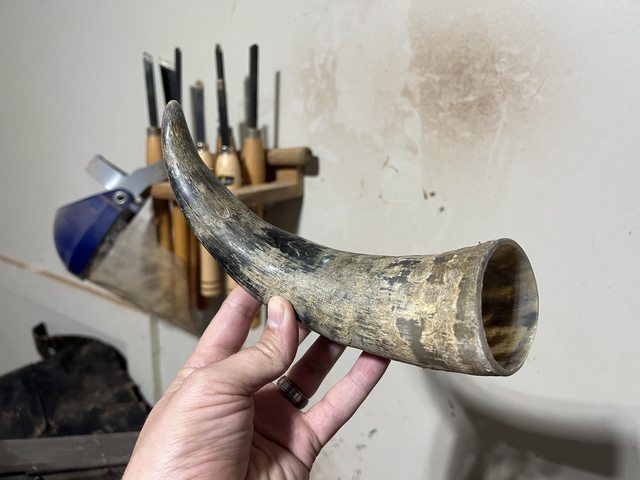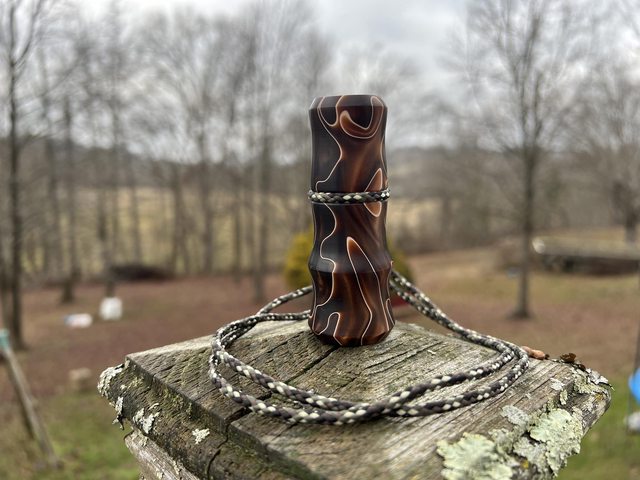I've been wanting to try a horn howler for a few months. I follow some call makers on social media that produce some beauties. My expectations were set much lower, trying something brand new. Here's what I started with.

I knew when I pulled the first horn out (I ordered a couple, expecting to ruin one or two) this was going to be a LOT of work. The trickiest part, to me, was where to cut the tip off to get started. I picked a spot thinking it was about the right diameter portion to cut and went at it with a hacksaw. It was solid horn, no hole at all when I cut that tip off. So I drilled a small hole to get a sense of how far I had to go. Luckily, it wasn't far, and I drilled a larger bore hole to accept a tenon of the reed/tone board "receiver." Basically a plug to accept the reed assembly. The lower end had a lot of damage on the horn so I cut that off to set the length of the horn body of the call. After a LOT of sanding and elbow grease, I was getting closer to what I was after.

Hard to see here, but basically the end of the call wasn't nearly as round as the receiver plug I turned out of "coal mine" (black) acrylic. I used a fine tip sharpie to outline the edge of the receiver so I knew where to sand to get the narrow end of the horn closer to round. Thank God for belt sanders. It made quick work of the job, then I hand sanded down to 800 grit by hand.

Now I'm getting really close.

This is sanded down to 800 on the horn and receiver. I wiped down the horn with a wet cloth to show the true color of the horn. Holding everything together, I ripped a few howls through it. It's got some serious volume, sounds pretty good.

At this point, I'm at a stand-still while I wait on some polishing compound I ordered to finish off the horn. I think it's coming next Monday. So far, I'm really happy with attempt #1. #2 will probably get started soon.

I knew when I pulled the first horn out (I ordered a couple, expecting to ruin one or two) this was going to be a LOT of work. The trickiest part, to me, was where to cut the tip off to get started. I picked a spot thinking it was about the right diameter portion to cut and went at it with a hacksaw. It was solid horn, no hole at all when I cut that tip off. So I drilled a small hole to get a sense of how far I had to go. Luckily, it wasn't far, and I drilled a larger bore hole to accept a tenon of the reed/tone board "receiver." Basically a plug to accept the reed assembly. The lower end had a lot of damage on the horn so I cut that off to set the length of the horn body of the call. After a LOT of sanding and elbow grease, I was getting closer to what I was after.

Hard to see here, but basically the end of the call wasn't nearly as round as the receiver plug I turned out of "coal mine" (black) acrylic. I used a fine tip sharpie to outline the edge of the receiver so I knew where to sand to get the narrow end of the horn closer to round. Thank God for belt sanders. It made quick work of the job, then I hand sanded down to 800 grit by hand.

Now I'm getting really close.

This is sanded down to 800 on the horn and receiver. I wiped down the horn with a wet cloth to show the true color of the horn. Holding everything together, I ripped a few howls through it. It's got some serious volume, sounds pretty good.

At this point, I'm at a stand-still while I wait on some polishing compound I ordered to finish off the horn. I think it's coming next Monday. So far, I'm really happy with attempt #1. #2 will probably get started soon.




















